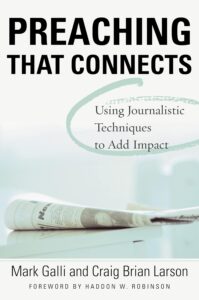Becoming More Creative In Your Preaching
Becoming More Creative In Your Preaching
 In the previous posts we considered how to keep your preaching fresh. You can read the stream by connecting to the first post in the series here. In this post I want to take a slight detour from that. I’ve been reading about how journalists do their work, and realized, thanks to a book by Mark Galli and Brian Larson, called, Preaching That Connects, that many of the learnings about journalism can be attributed to preaching as well. In today’s post we will explore how becoming more creative in your preaching will help your audience listen well, and hopefully experience transformation.
In the previous posts we considered how to keep your preaching fresh. You can read the stream by connecting to the first post in the series here. In this post I want to take a slight detour from that. I’ve been reading about how journalists do their work, and realized, thanks to a book by Mark Galli and Brian Larson, called, Preaching That Connects, that many of the learnings about journalism can be attributed to preaching as well. In today’s post we will explore how becoming more creative in your preaching will help your audience listen well, and hopefully experience transformation.
Creativity In Preaching is a Process
I have always admired writers. Those who write for journals must consistently find creativity. I think of them especially in the times when I have preachers’ block, those times when I just can’t seem to identify the best way to communicate my subject.
Two different thought processes are involved in writing and preaching.
The generative process produces ideas. Thoughts multiply. Ideas lead one to the other. Some compare it to a tree sprouting in spring. New life blossoms.
Evaluative thinking, on the other hand, is more akin to the person who prunes the tree for maximum growth. Evaluative thinking throws ideas away.
When The Creativity Doesn’t Come
So, you get stuck. If you preach regularly, there are times that you sit there in preparation, wondering how to formulate your message. What do you do then? Here are some suggestions for becoming more creative in your preaching practice.
Use A Heuristic
The first idea is to employ a heuristic. That’s a Greek word that means at its root, “to find out”. It is a list of questions that can begin to unlock the creative side of your brain. A Heuristic is basically a list of questions that you go through and write notes as you reflect on the passage. Here are some questions recommended by Gallo and Larsen:
- To whom am I speaking?
- How should the text affect the way my listeners live tomorrow?
- What are the word pictures in this text, and how can I use them as “running “scenery” in the sermon?
- Who will benefit from the truths in this text?
- What felt needs and real needs does this text address?
- What principles does this text teach?
- How have I experienced the truth of this text?
More Questions to Ask
- What are the truth tensions related to this verse (for example, sovereignty and free will)?
- What is the purpose of this sermon?
- What is the cause, nature and effect?
- How do I define the key words and ideas?
- How does this compare and contrast with related subjects?
- What does the text call us to do, say, think, or stop doing, saying, thinking?
- What is the good news, the hopeful aspect of this text?
- How would skeptics object to this verse, and how can I answer them.
- What emotions are touched by this text?
- Have there been any stories in the news lately that relate to this subject?
- What key doctrine does this text teach or illustrate?
- What assumptions of our culture does this text challenge?
Quite a list! I can almost guarantee that if you subject a budding sermon to these kinds of questions , ideas will start bubbling. You’ll find that you are becoming more creative in your preaching ministry.
Talk About Your Message With Some Creative People
 Talking to some creative people can unlock all sorts of ideas for you. Ask a group of people to meet with you the day before you write your message. Tell them your main points, and let them brainstorm about how this hits them, and how they would recommend presenting it. You’ll find creativity blooming.
Talking to some creative people can unlock all sorts of ideas for you. Ask a group of people to meet with you the day before you write your message. Tell them your main points, and let them brainstorm about how this hits them, and how they would recommend presenting it. You’ll find creativity blooming.



